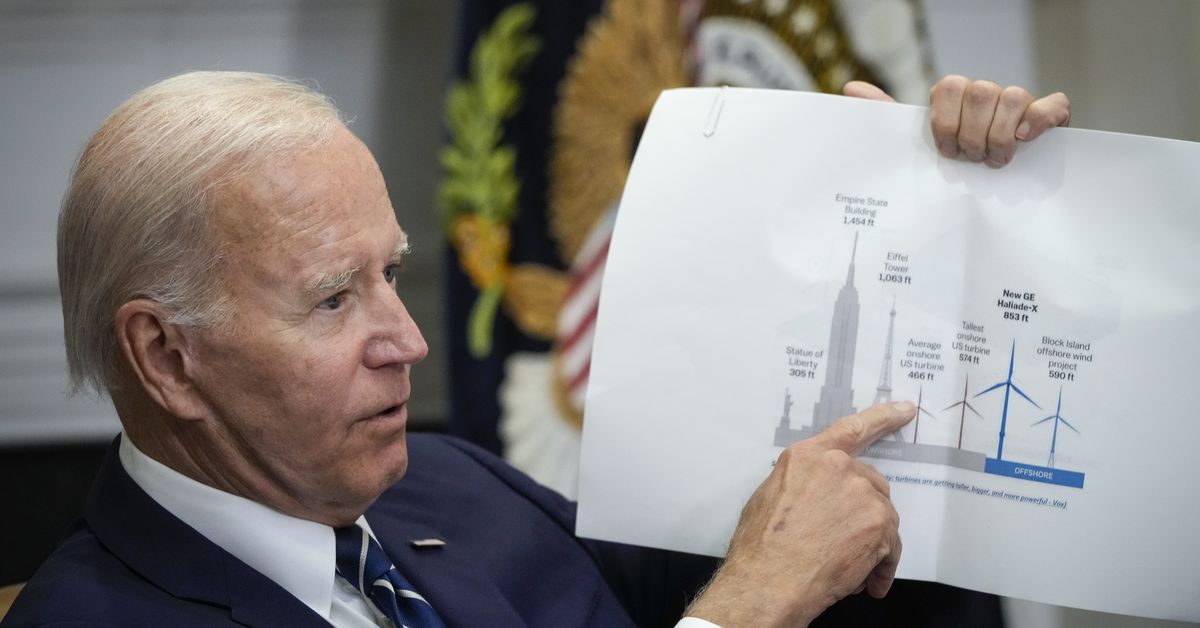Wind farms could join oil rigs in the Gulf of Mexico
The Biden administration is eyeing chunks of the Gulf of Mexico as new areas to expand its growing offshore wind ambitions. Today, President Joe Biden proposed opening up 700,000 acres off the coasts of Galveston, Texas and Lake Charles, Louisiana to future wind development. The administration is now looking for public input on developing those locations, after its proposal today to make them official “wind energy areas” where lease sales could be held in the future.
Building up an offshore wind energy industry in the US has been a big part of the Biden’s administration’s goals on climate change. There’s very little of it right now — just two small wind farms operating off the coasts of Rhode Island and Virginia. The first commercial-scale offshore wind farm, being built off the coast of Massachusetts, just got federal approval in May 2021.
Since then, Biden has tried to kickstart offshore wind development along other shorelines outside the East Coast. The administration created two new wind energy areas off of California, and is also looking into locations off the Oregon coast.
The Gulf of Mexico generally has smaller waves and shallower waters than either the Atlantic and Pacific coasts — making the area appealing for offshore wind. But the Gulf also has some unique challenges. Future wind farms in the Gulf will have to contend with tropical storms and hurricanes. The record-smashing 2020 Atlantic hurricane season included five storms named storms that struck Louisiana. Two of those, hurricane Laura and Delta, dealt heavy blows to Lake Charles.
Looking beyond climate and geography, the history of oil and gas drilling here could also support a budding clean energy industry, particularly when it comes to vessels needed to build out offshore infrastructure. Already, New Orleans, Louisiana is home to the US’ first private testing facility for new offshore wind turbine blade technology.
Wind turbines in the Gulf of Mexico could generate up to 508 gigawatts of electricity, according to a 2020 study by the National Renewable Energy Lab, twice as much energy as Gulf states cumulatively consume. The 700,000-acre area the Biden administration now wants to open up for wind farm development could eventually supply enough electricity for over three million homes, according to a White House fact sheet.
Biden today also directed the Department of Interior to “advance clean energy development” in federal waters in the Atlantic off the coasts of Florida, Georgia, South Carolina, and North Carolina. There aren’t much details out yet, but this move counters a Trump-era moratorium on offshore wind development in that region.
Last year, Biden set a goal of deploying 30 gigawatts of offshore wind generation by 2030, which the White House says could power 10 million homes. As part of that effort, Biden announced a new partnership with states last month to build up the domestic supply chain for offshore wind technologies and infrastructure.
Bigger picture, Biden is trying to hit a global target that scientists have found is necessary to keep the risks posed by climate change from growing significantly worse. The US, the world’s second-biggest climate polluter, has committed to halving its emissions this decade from peak levels under the Paris climate agreement.
Success depends heavily on cleaning up the power sector. But so far, Democrats’ most ambitious efforts to wipe out emissions from the nation’s electricity consumption have fallen flat. The Supreme Court handed down a decision last month that limits the EPA’s ability to regulate greenhouse gas emissions from power plants.
And last week Senator Joe Manchin (D-WV) killed a key climate plan Democrats have been trying to push forward since last year. After months of stalling and watering down the proposed legislation, Manchin refused to support the climate package that would promote clean energy through $300 billion in tax credits. If passed, it would have been the single biggest measure Democrats have taken to slash greenhouse gas emissions. Without it, the US is far off track from meeting the pledge it made under the Paris climate agreement.
Now, the US will have to cobble together many smaller actions to reduce pollution at the speed and scale necessary to keep climate change from getting much worse. “Since Congress is not acting on this emergency, President Biden will,” the White House fact sheet on today’s announcement says.
Biden discussed the new moves today from a shuttered coal-fired power plant that will now be used to make subsea cables for offshore wind installations. Along with the Gulf of Mexico news, the Biden administration also announced new funding to help communities build up infrastructure that’s more resilient to climate change-driven disasters like floods, fires, and heatwaves.
Advocates are also pressuring Biden to declare a national emergency on climate. Doing so would give the president more authority to stop offshore oil and gas drilling, ban crude oil exports, and limit international trade and investment in fossil fuels. Biden would also be able to direct the Federal Emergency Management Agency to build out renewable energy generation, and funnel more money into the domestic manufacturing of clean energy technologies.
For all the latest Technology News Click Here
For the latest news and updates, follow us on Google News.

